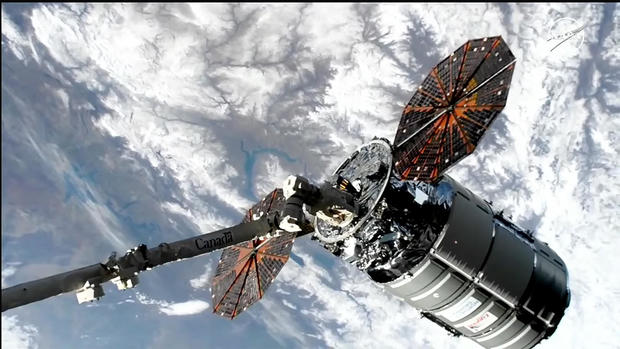
A cargo ship from Northrop Grumman has delivered 4 tons of supplies and equipment to the space station.
On Thursday, a Northrop Grumman Cygnus spacecraft successfully rendezvoused with the International Space Station. The spacecraft delivered over four tons of equipment and supplies to the station, including ice cream and other goodies for the seven astronauts on board.
Astronaut Loral O’Hara, using the laboratory’s arm built by Canada while inside the space station, secured a hold on a grapple fixture located at the bottom of the cargo ship at 4:59 a.m. EST, concluding a two-day rendezvous. The Johnson Space Center in Houston then took control to guide the craft to dock at the central Unity module.
“We would like to extend our congratulations to the team at Northrop Grumman and NASA for their successful launch and capture,” O’Hara announced over the radio. “We understand the immense dedication and hard work required to make these missions a success, and we are grateful for all your efforts in ensuring its success.”
NASA
Launched Tuesday
The cargo ship, launched on a SpaceX Falcon 9 rocket from the Kennedy Space Center, carried a total of 2,490 pounds of crew supplies, 3,017 pounds of science equipment, 2,493 pounds of space station hardware, and approximately 185 pounds of computer gear and spacewalk equipment to the station.
The scheduled two-week research trip will continue as scheduled, with the plan to undock on Saturday, depending on weather conditions. The crew will then return to Earth using their SpaceX Crew Dragon capsule, concluding the third privately-funded astronaut mission organized by Axiom Space, based in Houston.
On the upcoming day, cosmonaut Oleg Kononenko, who was sent to the station in September last year, will achieve a new record for the longest time spent in space. He will have logged a total of 879 days in orbit across five missions, surpassing the previous record held by cosmonaut Gennady Padalka. Kononenko, along with his crewmate Nikolai Chub, is currently on a one-year mission and is set to reach 1,000 days in space in early June.
The upcoming departure of the Ax-3 crew this weekend will open up the opportunity for NASA to send four new long-term crew members to the station later this month. This will happen after the scheduled launch of a privately constructed moon lander from the Kennedy Space Center pad.
If the scheduled moon mission is postponed, the launch for Crew 8, consisting of commander Matthew Dominick, astronaut-physician Michael Barratt, astronaut Jeanette Epps, and cosmonaut Alexander Grebenkin, will occur on February 22nd. However, if the lunar flight remains on schedule, Dominick and his team will take off approximately one week later.
In any case, the following individuals will take the place of the current Crew 7 astronauts: Jasmin Moghbeli, Andreas Mogensen from the European Space Agency, Satoshi Furukawa from Japan, and Konstantin Borisov, a cosmonaut.
Sent to the remote station in August of last year.
They intend to return home in the beginning of March.
This will establish the conditions for another crew-rotation mission, which will be carried out by Russia.
On March 21, the Soyuz MS-25/71S spacecraft will be launched from the Baikonur Cosmodrome in Kazakhstan. Its mission is to transport veteran cosmonaut Oleg Novitskiy, Belarus guest flier Marina Vasilevskaya, and NASA veteran Tracy Dyson to the laboratory complex.
Assuming everything goes as planned, Novitskiy, Vasilevskaya, and O’Hara are scheduled to come back to Earth on April 2nd using the Soyuz MS-24/70S spacecraft.that carried Kononenko, Chub and O’Hara into space last September.
Dyson will remain on the International Space Station (ISS) with Kononenko and Chub. She will accompany them on the journey back to Earth in September via the Soyuz MS-25/71S spacecraft.
More
More
Source: cbsnews.com